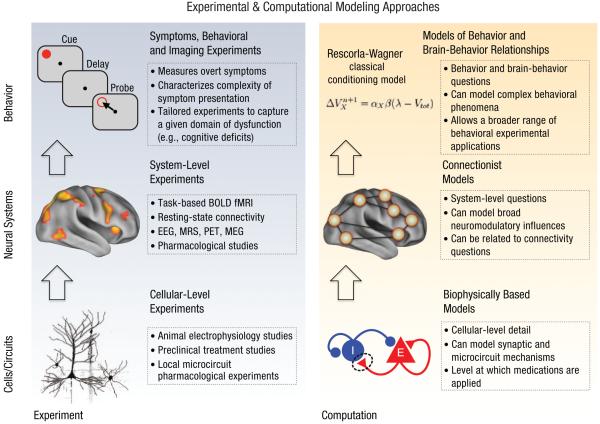Fig. 1.
Conceptual illustration of computational modeling and experimental interplay across levels of analysis. The utility of computational modeling, particularly in the study of schizophrenia, is its ability to inform a given level of experimental study. Because we study abnormalities in schizophrenia from the cellular level (Lewis, Hashimoto, & Volk, 2005), at the neural-system level (Anticevic, Repovs, Corlett, & Barch, 2011), and, ultimately, at the level of behavior (Gold et al., 2012), we have to utilize our modeling approaches to best fit the experimental framework. For instance, as reflected in the bottom panels, cellular-level experiments use techniques and produce measurements that are best captured using models that contain the necessary level of biophysical realism. Such models can, for instance, inform synaptic processes that may govern the microcircuit phenomena under study, such as neural oscillations (X.-J. Wang, 2010). In turn, a number of neuroimaging studies have focused on characterizing system-level disturbances in schizophrenia using both task-based paradigms (Barch & Ceaser, 2012) and resting-state functional connectivity approaches (Fornito, Zalesky, Pantelis, & Bullmore, 2012). Such system-level cognitive neuroscience experiments are best informed by models that capture the relevant detail and complexity of larger-scale neural systems (as reflected in the middle panels). Such models can perhaps better inform the role of systemic pharmacological manipulations on BOLD fMRI (Honey & Bullmore, 2004) or can be used to predict results of functional connectivity studies in schizophrenia (Yang et al., 2014). Finally, schizophrenia produces complex and devastating behavioral symptoms, which can be measured via increasingly sophisticated behavioral paradigms (Gold et al., 2012; Waltz et al., 2009; Waltz & Gold, 2007). Here, the use of models that formalize complex behavior (as reflected in the top panels) can provide a powerful tool to quantitatively examine a given behavioral process in patients (e.g., reinforcement learning; Maia & Frank, 2011) as well as brain-behavior relationships (Gradin et al., 2011; G. K. Murray et al., 2008; Schlagenhauf et al., 2014). BOLD fMRI = blood-oxygen-dependent-level functional MRI; EEG = electroencephalography; MRS = magnetic resonance spectroscopy; PET = positron emission tomography; MEG = magnetoencephalography; E = excitatory cells; I = inhibitory cells.

